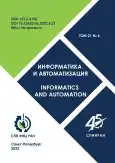A Comparative Study by Simulation of OSPF and EIGRP Routing Protocols
- Authors: Tsochev G.R1, Popova K.K1, Stankov I.S1
-
Affiliations:
- Technical University of Sofia
- Issue: Vol 21, No 6 (2022)
- Pages: 1240-1264
- Section: Digital information telecommunication technologies
- URL: https://journal-vniispk.ru/2713-3192/article/view/267201
- DOI: https://doi.org/10.15622/ia.21.6.6
- ID: 267201
Cite item
Full Text
Abstract
Computer networks are based on technology that provides the technical infrastructure where routing protocols are used to transmit packets over the Internet. Routing protocols define how routers communicate with each other by distributing information. They are used to describe how routers communicate with each other, learn available routes, build routing tables, make routing decisions, and share information between neighbors. The main purpose of routing protocols is to determine the best route from source to destination. A particular case of a routing protocol operating within an autonomous system is called an internal routing protocol (IGP – Interior Gateway Protocol). The article analyzes the problem of correctly choosing a routing protocol. Open Shortest Path First (OSPF) and Enhanced Interior Gateway Routing Protocol (EIGRP) are considered leading routing protocols for real-time applications. For this they are chosen to be studied. The main objective of the study is to compare the proposed routing protocols and to evaluate them based on different performance indicators. This assessment is carried out theoretically – by analyzing their characteristics and action, and practically – through simulation experiments. After the study of the literature, the simulation scenarios and quantitative indicators by which the performance of the protocols is compared are defined. First, a network model with OSPF is designed and simulated using the OPNET Modeler simulator. Second, EIGRP is implemented in the same network scenario and a new simulation is done. The implementation of the scenarios shall collect the necessary results and analyze the operation of the two protocols. The data shall be derived and an assessment and conclusion shall be made against the defined quantitative indicators.
Keywords
About the authors
G. R Tsochev
Technical University of Sofia
Author for correspondence.
Email: gtsochev@tu-sofia.bg
boulevard Kliment Ohridski 8
K. K Popova
Technical University of Sofia
Email: kpopova@tu-sofia.bg
boulevard Kliment Ohridski 8
I. S Stankov
Technical University of Sofia
Email: istankov@tu-sofia.bg
boulevard Kliment Ohridski 8
References
- Biradar A.G. A Comparative Study on Routing Protocols: RIP, OSPF and EIGRP and Their Analysis Using GNS-3. 2020 5th IEEE International Conference on Recent Advances and Innovations in Engineering (ICRAIE), 2020. pp. 1-5. doi: 10.1109/ICRAIE51050.2020.9358327.
- Athira M., Abrahami L., Sangeetha R.G. Study on network performance of interior gateway protocols – RIP, EIGRP and OSPF. 2017 International Conference on Nextgen Electronic Technologies: Silicon to Software (ICNETS2), 2017. pp. 344-348. doi: 10.1109/ICNETS2.2017.8067958.
- Panagiotopoulou V. Simulation-based Comparative Study of OSPF and EIGRP Routing Protocols. University of Derby, school of computing & mathematics, 2015. doi: 10.13140/RG.2.2.29429.47847.
- Kurose J.F., Ross K.W. Computer Networking. 8th edn. Pearson Education, 2020. 957 p.
- Medhi D., Ramasamy K. Network Routing: Algorithms, Protocols, and Architectures. 2nd edition, Oxford, U.K.: Elsevier Inc., 2017. p. 1018.
- Pei D., Massey D., Zhang L. A formal specification for RIP protocol, UCLA CSD Technical Report TR040046, 2004.
- Rakheja P., Kaur P., Gupta A., Sharma A. Performance Analysis of RIP, OSPF, IGRP and EIGRP Routing Protocols in a Network. International Journal of Computer Applications. 2012. vol. 48. pp. 6-11. doi: 10.5120/7446-0401.
- Yong L., Reddy A.L.N. A fast rerouting scheme for OSPF/IS-IS networks. Proceedings. 13th International Conference on Computer Communications and Networks (IEEE Cat. No.04EX969). 2004. pp. 47-52. doi: 10.1109/ICCCN.2004.1401585.
- Haas Z.J., Pearlman M.R. The Performance of Query Control Schemes for the Zone Routing Protocol. IEEE/ACM Transactions on Networking (TON). 2001. vol. 9. no. 4. pp. 427-438.
- Hinds A., Atojoko A., Zhu S.Y. Evaluation of OSPF and EIGRP Routing Protocols for IPv6. International Journal of Future Computer and Communication. 2013. vol. 2. no. 4. pp. 287-291.
- Ferguson D., Moy J. OSPF Version 3, RFC 5340. Sycamore Networks, Inc., 2008.
- Graziani R., Johnson A. Routing Protocols and Concepts, CCNA Exploration Companion Guide. London: Pearson Education. Companion Guide series, 2008.
- Goyal M. et al. Improving Convergence Speed and Scalability in OSPF: A Survey. IEEE Communications Surveys & Tutorials. Second Quarter. 2012. vol. 14. no. 2. pp. 443-463. doi: 10.1109/SURV.2011.011411.00065.
- Karna H., Baggan V., Sahoo A.K., Sarangi P.K. Performance Analysis of Interior Gateway Protocols (IGPs) using GNS-3, 2019 8th International Conference System Modeling and Advancement in Research Trends (SMART). 2019. pp. 204-209. doi: 10.1109/SMART46866.2019.9117308.
- Leahy E. EIGRP – Packets & Neighborships. Available at: http://ericleahy.com/index.php/eigrp-packets-neighborships/. (accessed 29.04.2022).
- FS Community IGRP vs OSPF: What's the Difference? Available at: https://community.fs.com/blog/eigrp-vs-ospf-differences.html. 2021. (accessed 26.5.2022).
- Tech Differences. Difference between EIGRP and OSPF. Available at: https://techdifferences.com/difference-between-eigrp-and-ospf.html (accessed 26.5.2022).
- CISCO OSPF Design Guide. Document ID: 7039. Available at: https://www.cisco.com/c/en/us/support/docs/ip/open-shortest-path-first-ospf/7039-1.html. 2022. (accessed 20.4.2022).
- CISCO Enhanced Interior Gateway Routing Protocol. Document ID: 16406. Available at: https://www.cisco.com/c/en/us/support/docs/ip/enhanced-interior-gateway-routing-protocol-eigrp/16406-eigrp-toc.html. 2020. (accessed 26.4.202).
- Arvind T. A Comparative Study of Various Network Simulation Tools. International Journal of Computer Science & Engineering Technology (IJCSET). 2016. vol. 7. no. 08. pp. 374-378.
- Sethi A., Hnatyshin V. The Practical OPNET User Guide for Computer Network Simulation. 1st edn. CRC Press. Available at: https://www.perlego.com/book/1606584/the-practical-opnet-user-guide-for-computer-network-simulation-pdf. 2012. (Accessed: 14 October 2022).
- Prokkola J. Simulations and Tools for Telecommunications. OPNET – Network Simulator. (MSc). University of Oulu, 2008.
- SYSC 4005/5001 SIMULATION AND MODELING. Introduction to Using OPNET Modeler, Avalilable at: http://www.sce.carleton.ca/faculty/lambadaris/courses/5001/opnet_tutorial.pdf (accessed 26.06.2022).
- Ivanova D., Mitev D. Usability strategy and guidelines for building an accessible web portal, AIP Conference Proceedings. AIP Publishing LLC. 2021. vol. 2333. no. 1.
Supplementary files









